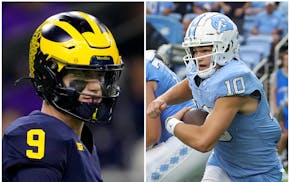Percy Harvin finished sixth in the NFL in catches last season, seventh in yards after catch, and he posted the third-highest rushing total by a wide receiver since the 1970 league merger.
Not bad for a guy who played only 58 percent of his team's offensive snaps.
Just imagine if the Vikings increase Harvin's workload and role, as promised.
"Anything this team needs," Harvin said, "I'm there."
The Vikings need to lean on their multipurpose dynamo more than ever this season, particularly at the outset. The team plans to ease Adrian Peterson back into action after major knee surgery, and receiver Jerome Simpson is unavailable the first three games while serving his suspension.
That bull's-eye already attached to Harvin's back figures to expand until the offense gets its full complement of playmakers.
"I'm sure Jacksonville will know where Number 12 is," Vikings cornerback Antoine Winfield said of Sunday's opening opponent.
He's impossible to ignore. The beauty of Harvin's game remains his versatility and ability to pressure defenses in myriad ways. Defensive players routinely bark out Harvin's whereabouts as he takes his pre-snap position.
He doesn't have a designated home, though. A natural slot receiver, Harvin also lines up split wide. He often motions across the formation and occasionally lines up in the backfield as a running back. Not many wide receivers are willing to run between the tackles -- and actually enjoy it.
"He's running at linebackers trying to run them over," Winfield said. "Most receivers don't do that."
Harvin is a special talent with a unique skill set. He might not consistently stack up Pro Bowl-caliber statistics purely as a wide receiver, but he deserves mention among the NFL's most dynamic players because of the sum of his contributions, including as a kick returner. He is the only player in Vikings history to score touchdowns three different ways -- rushing, receiving, return -- in multiple seasons.
"That's kind of fun to be that rabbit, the guy that can go any way," he said. "Teams don't know where I'm going to be at. I take pride in that and take pride in learning different positions and can play all of them."
Harvin caught a career-high 87 passes last season. He gained 566 yards after the catch, the third-best total by a receiver, according to Stats Inc. New England's Wes Welker led the league with 751 yards after catch, but he caught 35 more passes and was targeted 51 more times than Harvin.
Harvin might be the best receiver in the NFL at turning short passes into big gains. He bounces off defenders like bumper cars, always fighting for extra yards, delivering his own punishment in the process. He's as tough as he is talented and never shortchanges a play.
"That's pretty much my game," he said. "Since I was younger, a lot of my routes are intermediate routes, not big chunks of yards. A lot of my yards come after the catch."
Harvin expects that to continue as he enters his fourth season. He appears to be in a good place now. By all accounts, he's been a happy camper after his minicamp meltdown this summer. The factors that triggered his unhappiness and temporary trade demand in June remain a mystery. Frankly, that whole ordeal, however brief, was puzzling.
Whether upset by his contract or role or a combination of things, Harvin went home to Florida and got himself right mentally and physically. He lost 10 pounds after playing at 200 pounds last season, and he's expressed nothing but positive thoughts to reporters since returning.
He had a quiet, drama-free training camp. That's a good thing. Harvin said he "got back to some of my roots" after critiquing his 2011 performance. He feels more explosive after returning to his college weight and he's worked on refining his route-running.
"I'm looking forward to seeing how it pays off," he said.
It's on the coaching staff to maximize that. Leslie Frazier said coaches must be "wise" in how and how much they use Harvin. His style of play is full-throttle so he absorbs considerable punishment, but he's also one of the few true difference-makers on this team.
Offensive coordinator Bill Musgrave understandably walks a fine line in defining Harvin's role, but using him on less than 60 percent of plays falls on the wrong side. He should never face questions about Harvin being underutilized.
Musgrave indicated the offense will feature some new "concepts" involving Harvin, which is smart. They should put the ball in Harvin's hands as many times as he can physically handle.
Nobody will fault them for that.
Scoggins: Why 'championship or bust' fits these Wolves

Scoggins: Anatomy of a game-saving play as Correa throws out Ohtani

Scoggins: McCarthy or Maye? Ex-U coach breaks down Vikings' options
Scoggins: Cory Provus getting ready for 'biggest challenge' of career


